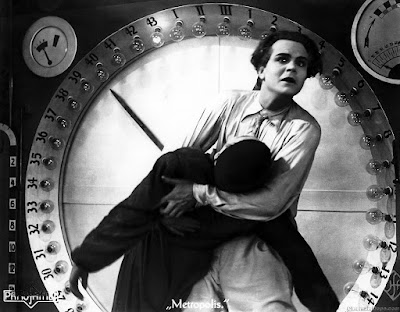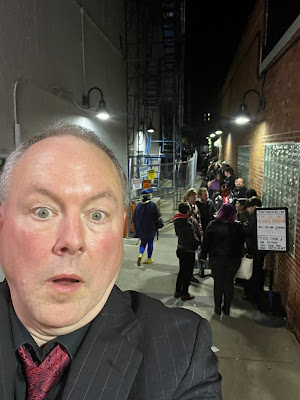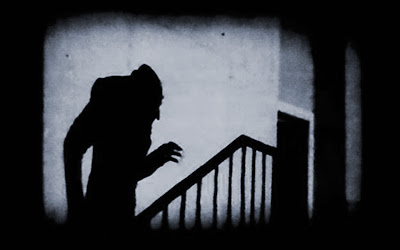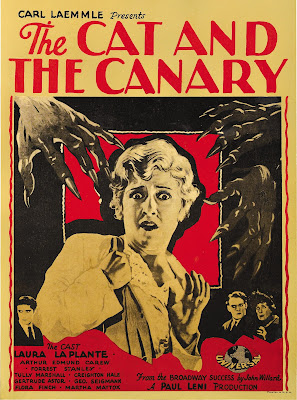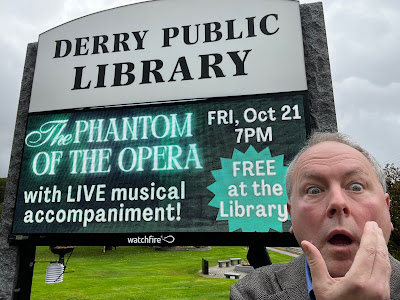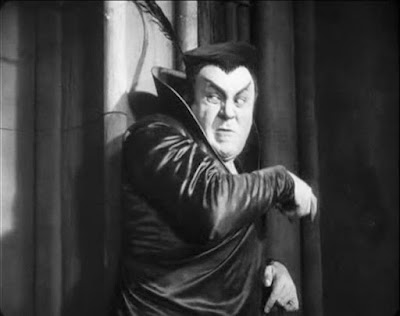An original lobby card promoting W.C. Fields in 'So's Your Old Man' (1926).Up next: I'll accompany a screening of 'So's Your Old Man' (1926), a terrific W.C. Fields silent comedy, on Wednesday, Nov. 16 at the Flying Monkey Moviehouse and Performance Center in Plymouth, N.H.
Showtime is 6:30 p.m. and yes, it's a silent film starring W.C. Fields. You won't hear his nasal twang and he sports a mustache, but give it a chance. I've found from experience that the Fields silents (those that survive, anyway) are great for audience response.
More about 'So's Your Old Man' in the press release below. Hope to see you in Plymouth on Wednesday night!
For now, here's a brief report of this year's Halloween marathon of silent film screenings, which reached a crescendo with three separate screenings in three states on the Saturday prior to spook day.
It got so busy that I really didn't have time to update the blog day-by-day. Hence this attempt to catch up.
The pre-show set-up in 'The Showroom' in Keene, N.H.Let's see...on Tuesday, Oct. 25, it was 'Nosferatu' (1922) at the new Showroom venue of the Colonial Theatre in Keene, N.H. It's called the "showroom" because it actually was originally the showroom of a car dealer!
I've been doing 'Nosferatu' pretty regularly for a long time, and everything clicked that night. Great reaction from an enthusiastic audience made of mostly first-timers for the silent film/live music experience.
Tools of the trade: the "dingy bell" I use to match the clock chimes in 'Nosferatu.'I got specific kudos from a young boy for the way I matched the bell chimes for the two times in 'Nosferatu' that a clock strikes midnight. It's a little tricky because both times characters on screen hear the clock before it's seen on camera.
If I do it just right, I can get 12 chimes exactly, and that's what happened, thus helping me build the pre-teen fan base for the silent film experience.
Pre-show poster posing at the Rex Theatre in Manchester, N.H.On Wednesday, Oct. 26, it was 'The Cat and the Canary' (1927) at the Rex Theatre in downtown Manchester, N.H. Another strong turnout for this lesser-known but entertaining comedy-thriller—people seemed to get what director Paul Leni was going for, and reacted strongly throughout.
In introducing the film, in order to demonstrate the "fame is fleeting" principle, I asked if any members of the Laura LaPlante club were present. Two hands went up immediately!
This is another film in which a clock striking midnight is featured prominently. In this case, it's a big old grandfather clock, and when the hour comes, Leni fills the screen with a prolonged montage of hammers hitting various coils to make the sounds.
No mere dingy bell will do this justice, so instead I switch the synthesizer to a setting named 'Valerian Bells,' which sounds like something from 'The Exorcist.' Once again I won after-screening praise for my bell effects! I thought "Heck, I'm on a roll."
But fate, and perhaps the spirit of Edgar Allen Poe, had other plans for me and my bells, bells, bells...
Loved this series poster at the Jane Pickens Theatre in Newport, R.I.On Thursday, Oct. 27, it was down to Newport, R.I., where the Jane Pickens Theatre was running 'Nosferatu.' To everyone's surprise and delight, well over 200 people crowded into the venerable venue to take in the vampire's exploits.
Having only started doing silent films this year in Newport, there's a great sense of discovery there, even with a film as familiar (to me, anyway) as 'Nosferatu.' The majority of attendees were first-timers, not just for 'Nosferatu' but for any silent film in a theater with live music.
Another poster in Newport. The Jane Pickens Theatre does a great job promoting screenings.And so audience reaction was intense and gratifying. They even laughed at my weak joke about preparing by means of braving the scary traffic getting through Boston on Route 128. Har!
And the music once again came together to support, I hope, what F.W. Murnau and his collaborators had put into the film so long ago. Altogether, it was one of highlights of the season: a packed house and that in-the-moment feeling that a film is really connecting, creating a shared experience by everyone present. Wow!
Pre-show inside the Jane Pickens Theatre. My little Roland speakers (seen on stage) do a great job, filling this sized house with a big sound when needed.Alas, it was this screening in which the bells got the best of me. After a half-dozen screenings of 'Nosferatu,' I screwed up both cues! Each time, I went to hit the dingy bell button, and literally missed the bell.
The first time, I succeeded in nearly knocking the bell off the chair, and so managed to get maybe only six dings before the movie moved on. That unnerved me enough to muff the second cue as well. It was a case of "not saved by the bell."
Friday, Oct. 28 saw me up at Warner, N.H. to accompany 'The Bells' (1926), an obscure thriller from obscure Chadwick Pictures that benefited from performances by the not-so-obscure Lionel Barrymore and Boris Karloff.
The screening, a fund-raiser for the Telephone Museum of N.H. (Yes, New Hampshire has a telephone museum. Doesn't your state?) and so 'The Bells' seemed an appropriate title.
Not the largest turnout of the season but the hall was pretty full and the film worked in spite of my clumsy attempts to integrate some toy sleigh bells into the score when needed.
This is where the bells got the best of me—fittingly in a film called 'The Bells.'
The bells referred to in the title are not telephone bells, but sleigh bells, the sound of which symbolize a murder that's committed during the picture.
Well, the best I could do in advance of this screening was to find a set of toy bells glued to felt that we found in my basement with a lot of old Christmas stuff.
I didn't have a chance to really test them out, and it turned out they were not even close to being up to the job. As I tried to shake them while playing keyboard with the other, they made virtually no sound. Instead of menacing, they sounded pathetic, at least to my ears.
Finally, one shake too many caused them to fly out of my hand and hit the floor, where I left them, getting my sleigh bell effects from the keyboard from then on. Strangely, a woman afterwards complimented me on how effective that was!
Dear Santa: please bring me a set of real sleigh bells. Also, while we're on the subject, a real boxing bell would be nice as well.
Saturday, Oct. 29 was the true one-day marathon: another 'Nosferatu,' this time a matinee at the newly opened Park Theatre in Jaffrey, N.H., then an evening screening of 'Der Golem' (1920) at the Leavitt Theatre in Ogunquit, Maine, followed then by a midnight screening of the reconstructed 'London After Midnight' (1927) at the Coolidge Corner Cinema in Brookline, Mass., just over the line from Boston.
The Leavitt Theatre, like all of Ogunquit, does not do Halloween halfway.Three states, three screenings, in 12 hours! And I had time for a piping hot bowl of bibimbap (see below) at the Korean Restaurant around the corner from the Coolidge, which thankfully stays open late on Saturday nights.
During this steeplechase, as far as the music goes, I was in kind of a trance. Sitting at the keyboard, it just flowed out of me. For 'Nosferatu,' it was a synthesis of all the material I'd been developing at the six previous screenings of the film I'd accompanied in the previous two weeks.
For 'Der Golem,' it was largely a riff on the theme from Bach's "Little Fugue in G minor." And 'London After Midnight' was total seat-of-the-pants improv based on three descending notes, which I have to say became thrillingly effective as the film progressed.
Risky selfie of me and the distinctive Coolidge marquee, obtained by stepping into Harvard Street in front of the theater.Besides the Korean food, it was powered by the adrenaline rush from seeing so many people in costume lined up for the Coolidge's annual Halloween overnight marathon, for which 'London After Midnight' was the opening film.
Adding to that was the sight of several large rats outside my car! Really—after the crowd had filed in, the rats came out of a dumpster area in an alley behind the theater and were apparently scavenging spilled popcorn and soda.
Me with the line of Coolidge marathon attendees stretching back into the alley, the end of which is where I later encountered rats guarding my car.This happened to be right where I parked my car for the load-in. Rather than be alarmed, my reaction was: "How cool to see this at Halloween!" Still, I had the presence of mind to make hissing noises to scare them off before moving the car out of there.
It was well past 1 a.m., but I couldn't miss the Coolidge Corner's costume contest! And then Sunday, Oct. 29 saw me accompanying a non-Halloween program at a new venue: the Gloucester Meetinghouse in Gloucester, Mass., an imposing structure that rises majestically out of the seaport's crowded old center.
The venue's silent film programs are usually accompanied by celebrated Boston-based organist Peter Krasinski, a good friend and colleague. But Peter was out of town and recommended me to fill in (thanks, Peter!) for a program of comedies: shorts by Charlie Chaplin and Buster Keaton, and then Chaplin's feature 'The Kid' (1921).
A beautiful fall afternoon with the Gloucester Meetinghouse in Gloucester, Mass.Weatherwise, it was a spectacular late October Sunday, but attendance was strong. One odd thing was that the church interior was noticeably warmer than it was outside. This was the result of a group using the building the night before accidentally leaving the heat cranked up to 85 all night long!
But the accidental combo of silent film and bikram-style yoga didn't stop the audience from enjoying the program, with many people afterwards praising 'The Kid' for its powerful emotional impact. Nice!
I perhaps lingered a bit too long, because I then found myself high-tailing it on Route 128 back to New Hampshire, where I just barely made it to the Town Hall Theatre in Wilton, N.H. for a 7:30 p.m. screening of Alfred Hitchcock's 'The Lodger' (1927).
For this one, I know the film somewhat, but hadn't done it in a long time. And coming at the end of a long series of screenings, there just wasn't an opportunity to view it or a chance to prepare anything in advance.
But at the same time, I'd been doing films nearly every day for the past three weeks. So in my favor was a state of unusual fluency, I'd have to say, that comes from sitting at a keyboard and creating music several hours in a row day after day.
And with 'The Lodger,' I just plunged in with a kind of aggressively syncopated jazz motif that turned out to be remarkably versatile in catching the various ups and downs of Hitchcock's first real 'Hitchcock' film: a tale of murder, false leads, misdirection, blonde women, and all the other Hitchcockian tropes we cherish.
It worked, and became one of the most satisfying accompaniment experiences of a busy stretch. No bells in this picture, but something similar: a cuckoo clock sounds twice, in close-up, at key moments, and both times I was ready.
I think overall, this spooky steeplechase reaffirmed one of the basic principles of silent film accompaniment, at least the way I do it. For me, the only way to develop and maintain fluency at improv-based accompaniment is to do it a lot.
When I do it a lot, I notice a difference. I'm able to get inside (and stay ahead) of a film in a way that seems almost effortless. The music just comes, and I find if I'm in that "zone" I can shape it to fit what the film seems to need at any given time.
But you can't keep this pace up indefinitely. So after 'The Lodger'—nothing! A whole note rest! The next week, including the weekend, I had no screenings—the first time since Labor Day.
Now, two weeks later, I'm back at it: I accompanied a benefit screening of 'Wings' last Thursday for the Aviation Museum of N.H. (of which I'm director), and this past Sunday did music for the silent version of 'All Quiet on the Western Front' (1930) at the Town Hall Theatre in Wilton, N.H.
The screening, in honor of Veterans Day, was well attended and the music came together in spectacular fashion. It was one of those shows where you're just in synch with everything—where an accompanist can feel the rhythm of the scenes and the editing and can anticipate, say, when there's a shell blast and can capture it as a big scene unfolds.
I had never scored the filim and had only previewed it once. But that was enough to be ready for a couple of big moments where the music seemed to really work well. One example: the scene where Raymond Griffith plays a dying French soldier.
Once he perishes, a character continues speaking to him, saying with increasing desperation he should have died instead. While that was going on, I kept to a moody ostinato in E minor.
But every so often, the camera cuts to Griffith's immobile face, just staring blankly ahead. And each time, I hit a C minor chord about an octave above, and held it for the duration of the shot.
It happens three times, and each time I pushed the volume a bit, and also added notes to the top of the chord. (It ended up being C minor with G Major on top.) I have to say, it made my hair stand on end, and I knew what was coming. I hope it had a similar affect on the audience.
And that's it for catching up. During the holiday season, the performance schedule often thins out, but not this year—I'm booked at venues pretty regularly into the next year, including two more gigs at the Coolidge in December and January. (No costumes, but more Korean food!)
But next up: it's W.C. Fields in 'So's Your Old Man' tomorrow night at the Flying Monkey. Press release is below. Hope to see you there!
* * *
A production still from 'So's Your Old Man' (1926).TUESDAY, NOV. 8, 2022 / FOR IMMEDIATE RELEASE
Contact Jeff Rapsis • (603) 236-9237 • jeffrapsis@gmail.com
Flying Monkey to screen rare silent film starring comic icon W.C. Fields
'So's Your Old Man' shows legendary performer as younger man; program on Wednesday, Nov. 16 accompanied by live music
PLYMOUTH, N.H.—He was a performer who could be recognized by just the nasal twang of his voice.
But
prior to reaching iconic fame in talking pictures, W.C. Fields
successfully starred in a popular series of silent feature films for
Paramount Pictures and other studios in the 1920s.
Rediscover the
non-talking W.C. Fields in 'So's Your Old Man' (1926) one of his best
silent pictures, in a screening on Wednesday, Nov. 16 at 6:30 p.m. at
the Flying Monkey Moviehouse and Performance Center, 39 Main St.,
Plymouth, N.H.
General admission is $10 per person, general
seating. Live musical scoring will be provided by silent film
accompanist Jeff Rapsis.
In 'So's Your Old Man' (1926),
Fields plays Sam Bisbee, inventor of a new shatter-proof windshield
glass and regarded as a crackpot by the townsfolk.
After
a demonstration of his glass to auto executives goes awry, he faces
ridicule and shame. On the way home, Bisbee encounters a woman he thinks
is trying to commit suicide, and so prevents her.
The woman is
really Princess Lescaboura, member of a family of European royalty, who
later arrives in Bisbee's home town to thank him, upending Bisbee's
life and setting the small town aflame with gossip. The film includes a
version of Fields' famous "golf" routine.
The film was remade as a
talkie in 1934, with W.C. Fields again starring, under the title
'You're Telling Me!' In 2008, 'So's Your Old Man' was added to the U.S.
National Film Registry.
W.C. Fields remains famous today for his
comic persona as a misanthropic and hard-drinking egotist with a
snarling contempt for dogs, children and women.
Although Fields
achieved lasting fame as a movie star in talking pictures of the 1930s,
his long career encompassed decades on the vaudeville stage as well as a
series of silent film roles in the 1920s.
"People find it hard
to think of W.C. Fields in silent films, but he was actually quite
successful," Rapsis said. "As a vaudeville performer and juggler, Fields
cultivated a form of visual comedy and pantomime that transferred well
to the silent screen.
"Also, as a middle-aged man during the
silent film era, he was able to play a family father figure—the kind of
role that wasn't open to younger comic stars such as Charlie Chaplin or
Buster Keaton," Rapsis said.
In all, Fields starred in 10 silent
features in the mid-1920s. Several are lost; in those that survive,
Fields sports a thick mustache, part of his vaudeville costume as a
"vagabond juggler" which he dropped in later years.
The film was
made not in Hollywood, but at the Paramount studios in Astoria, Queens, a
popular production facility for New York-based stage performers who
also appeared in film.
For the music, Rapsis improvises in real
time, while the film is running, using a digital synthesizer that allow
him to recreate the "movie score" texture of a full orchestra.
"Improvising
a score live is a bit of a high-wire act, but it allows me to follow
and support the film a lot more effectively than if I was buried in
sheet music," Rapsis said.
"Instead, I'm free to follow the film
right in the moment. Each time it's different, which lends a certain
energy and immediacy and excitement to the experience."
'So's
Your Old Man,' a silent comedy starring W.C. Fields, will be screened
with live music on Wednesday, Nov. 16 at 6:30 p.m. at the Flying Monkey
Moviehouse and Performance Center, 39 Main St., Plymouth, N.H.
Admission is $10 per person. For more info, call (603) 536-2551 or visit
www.flyingmonkeynh.com.


